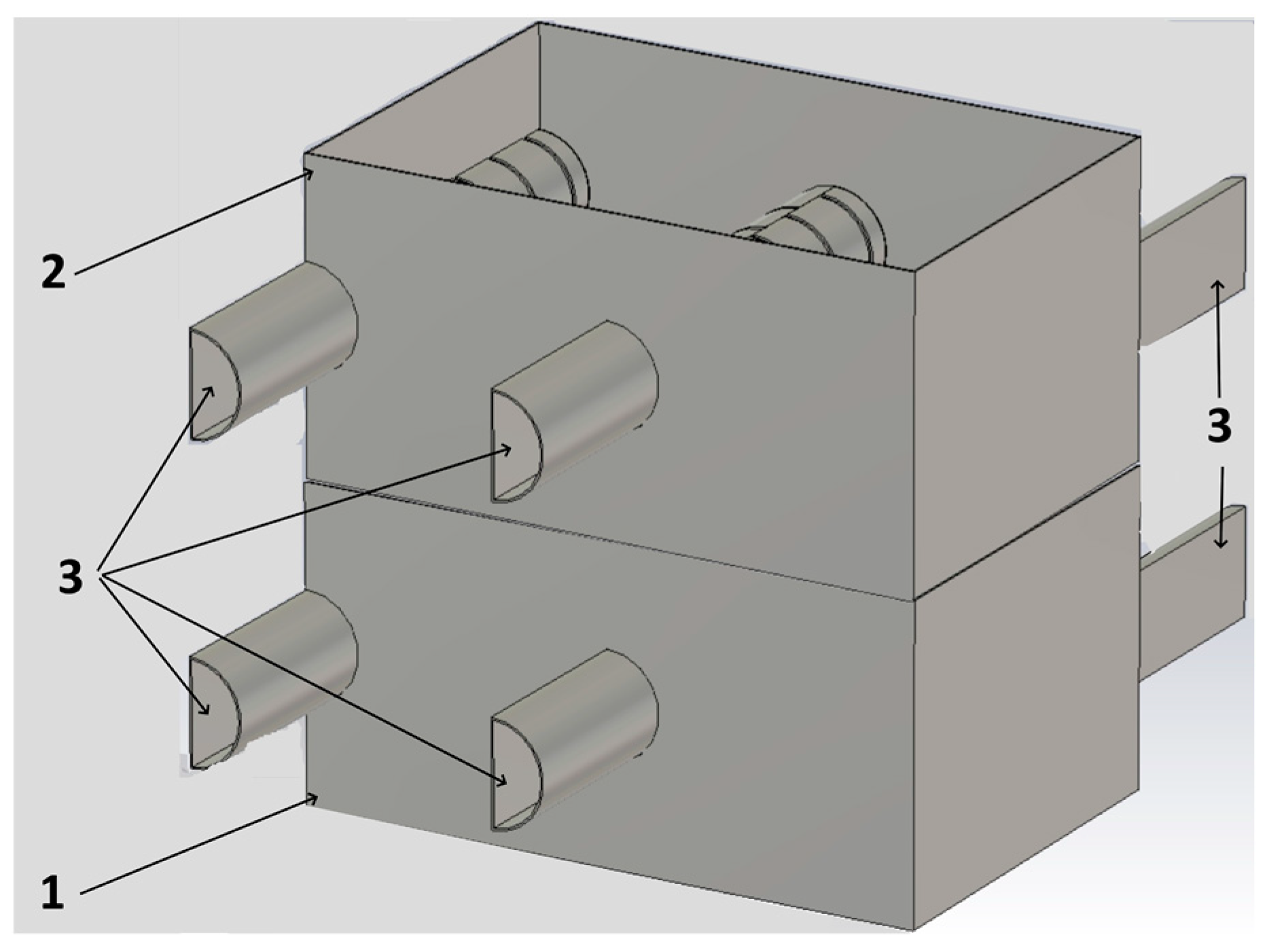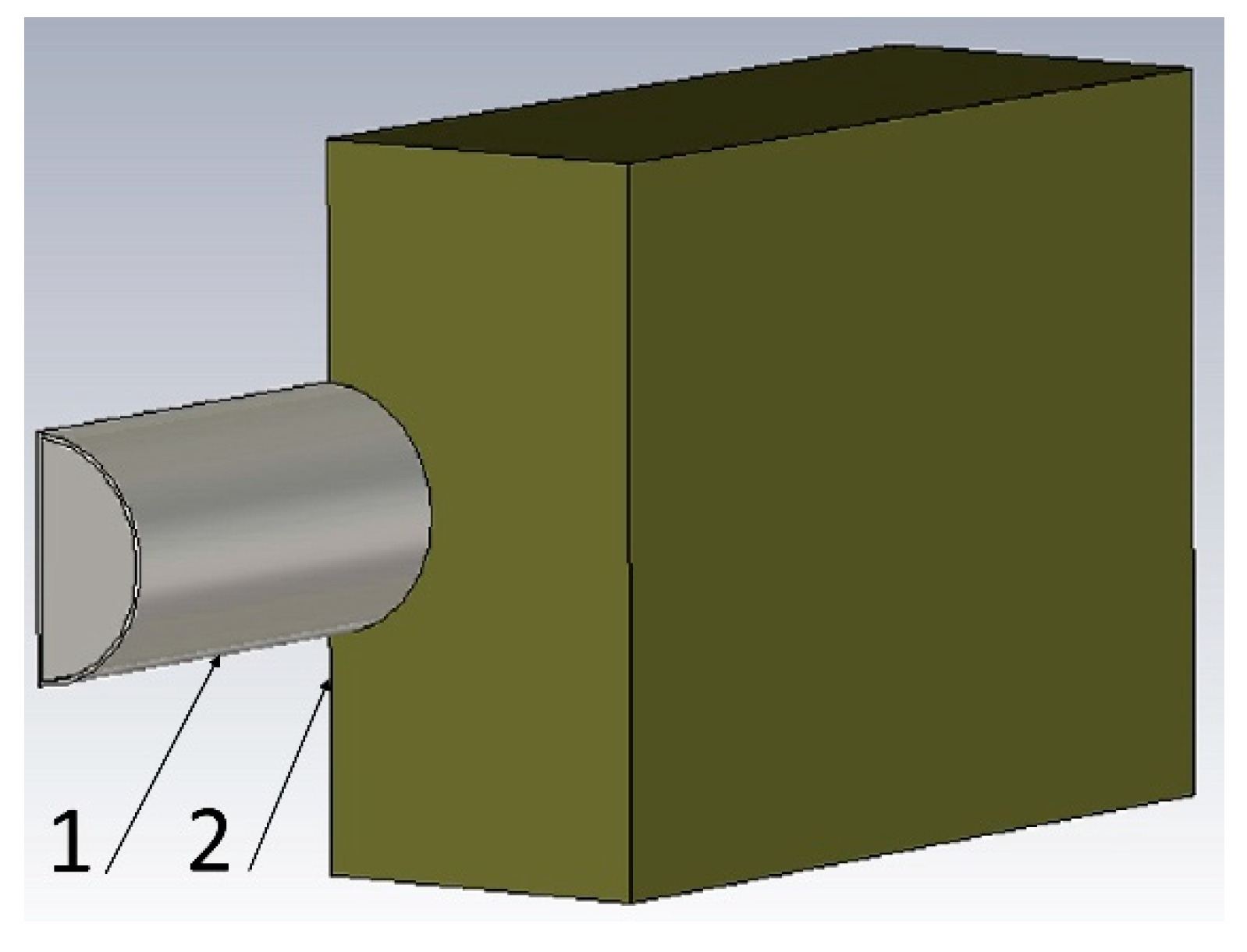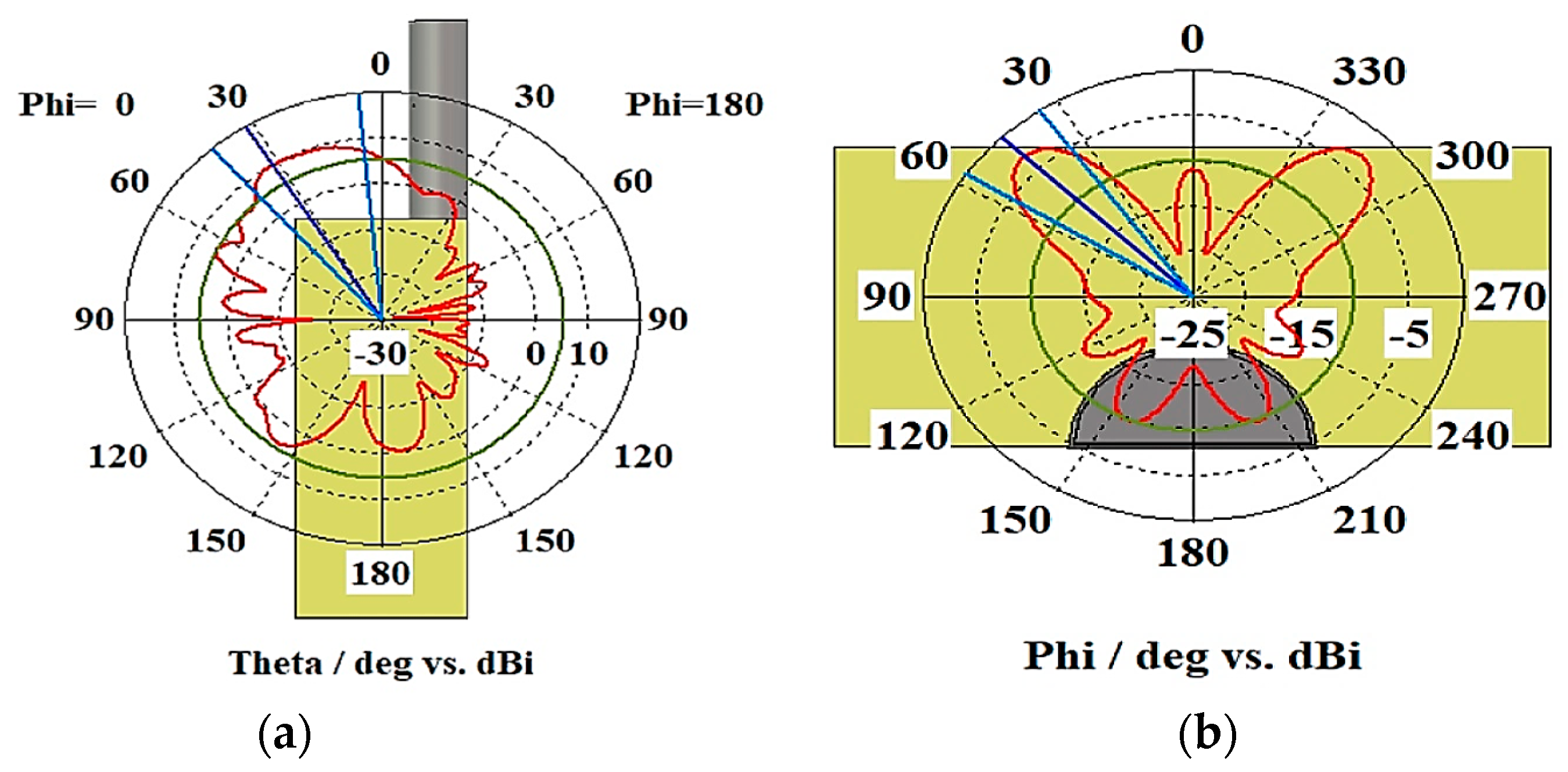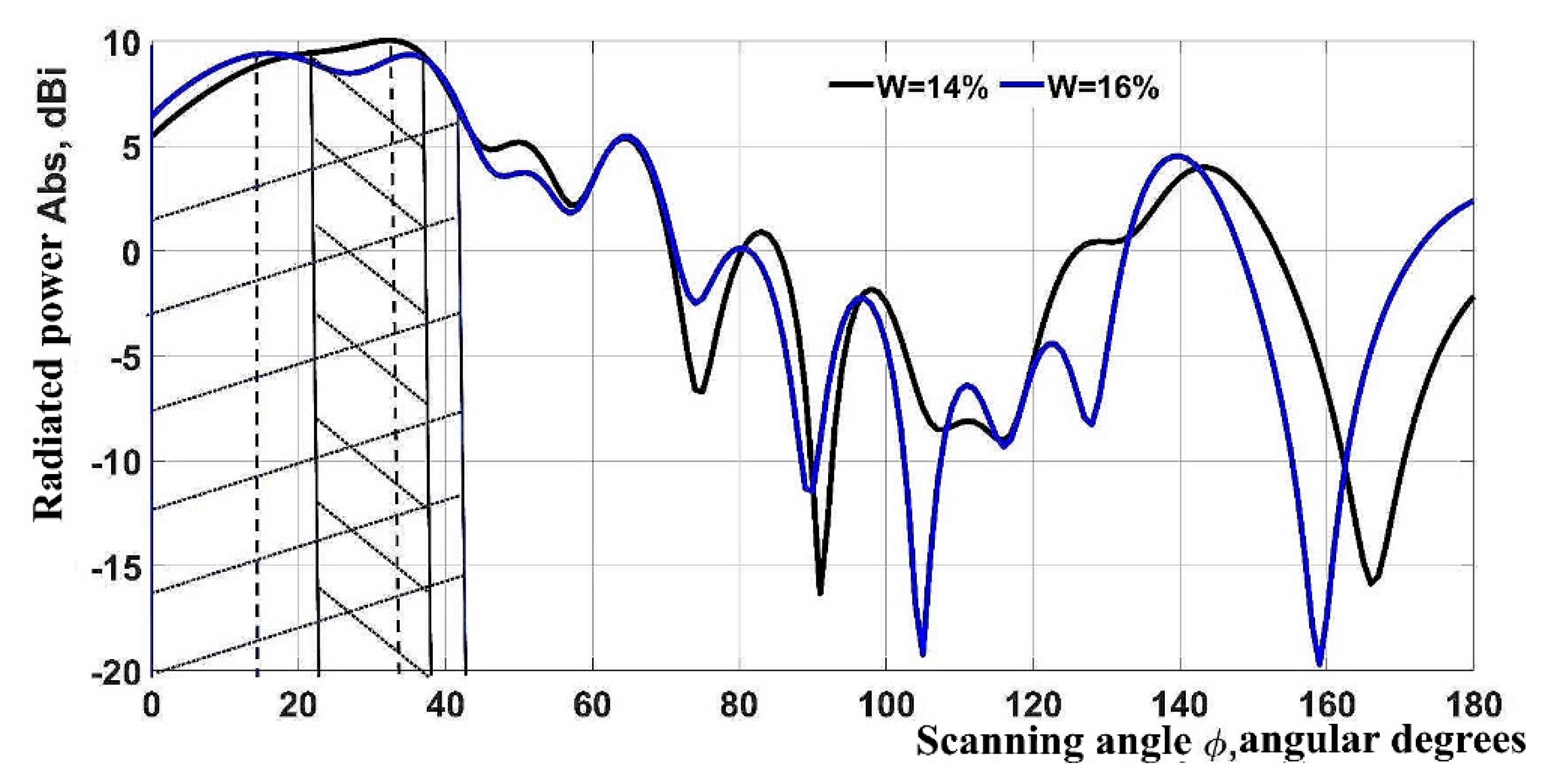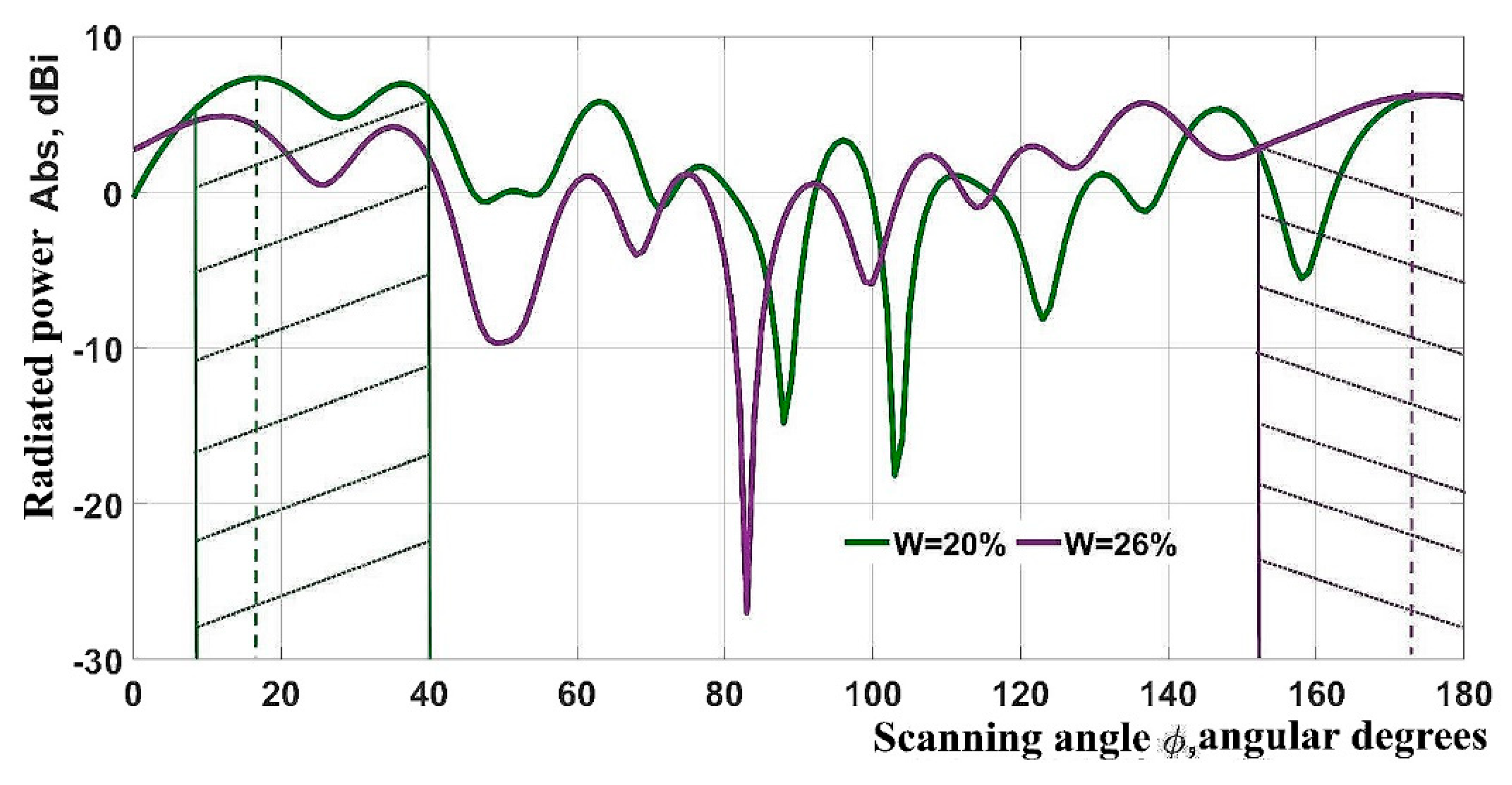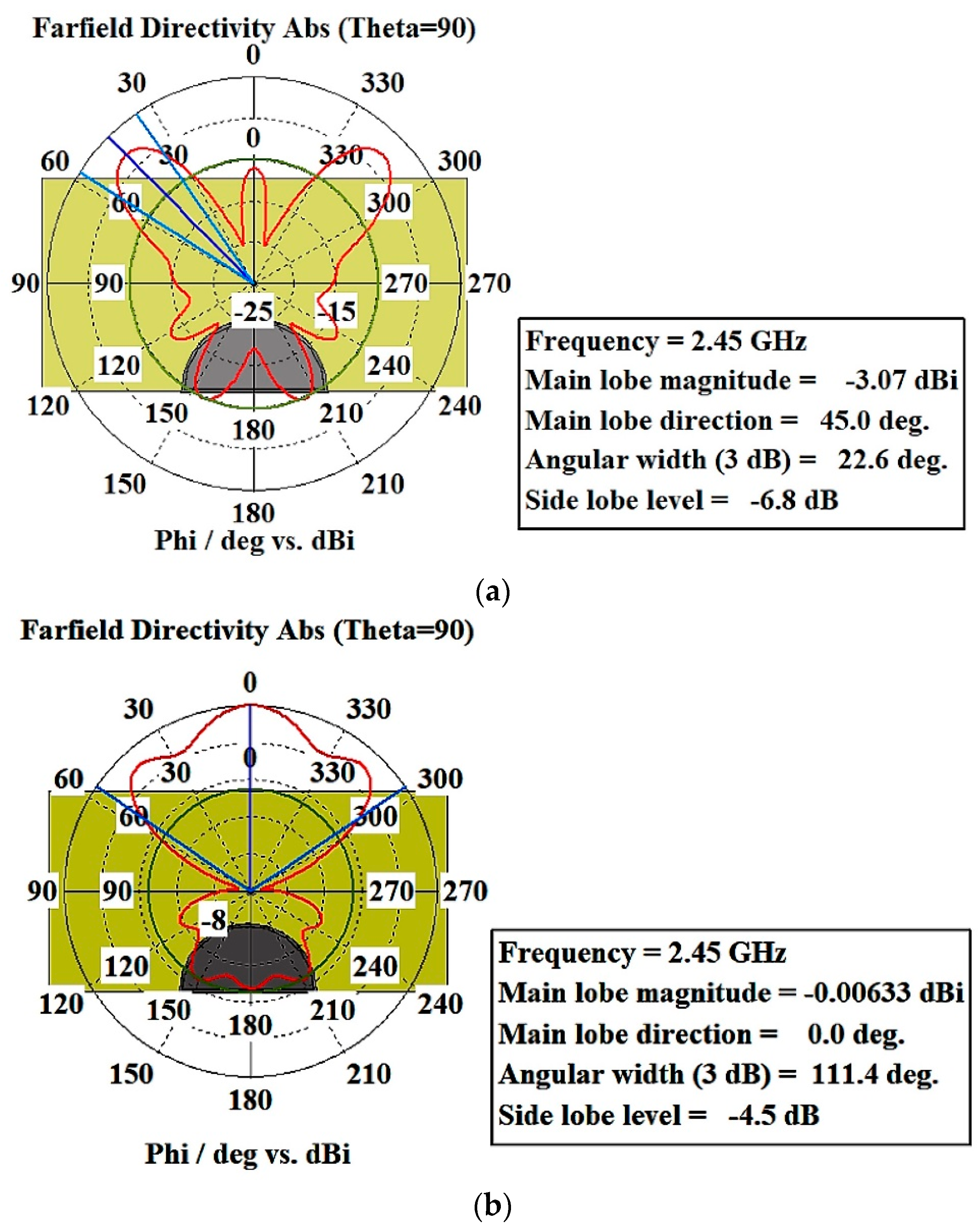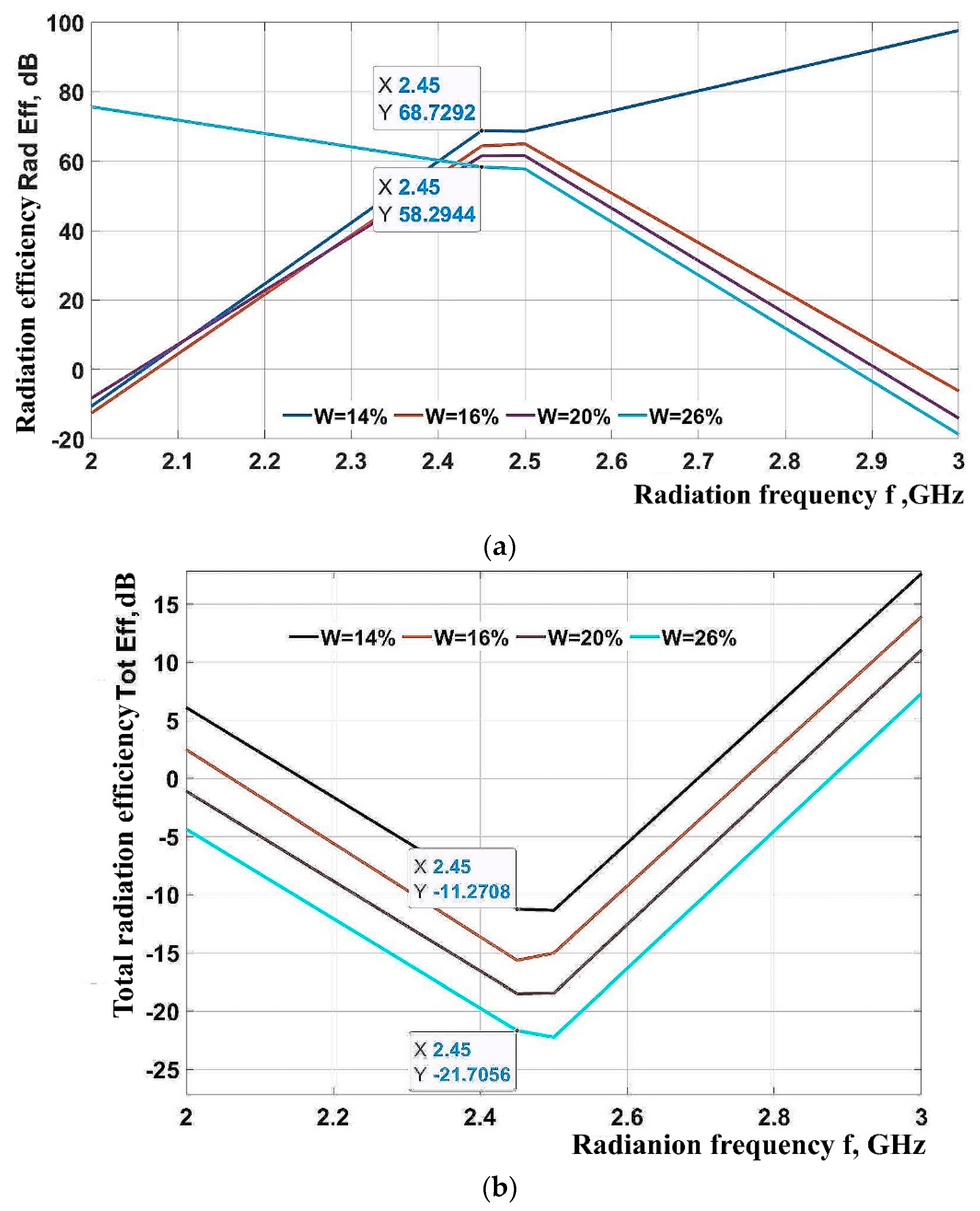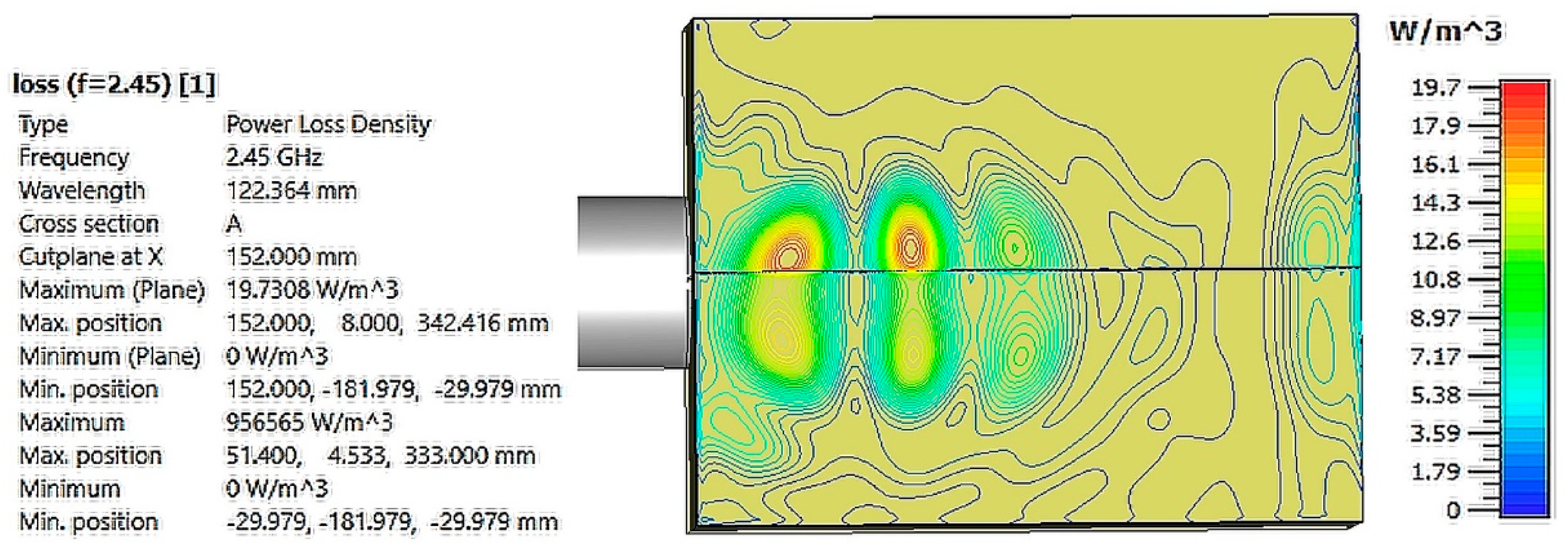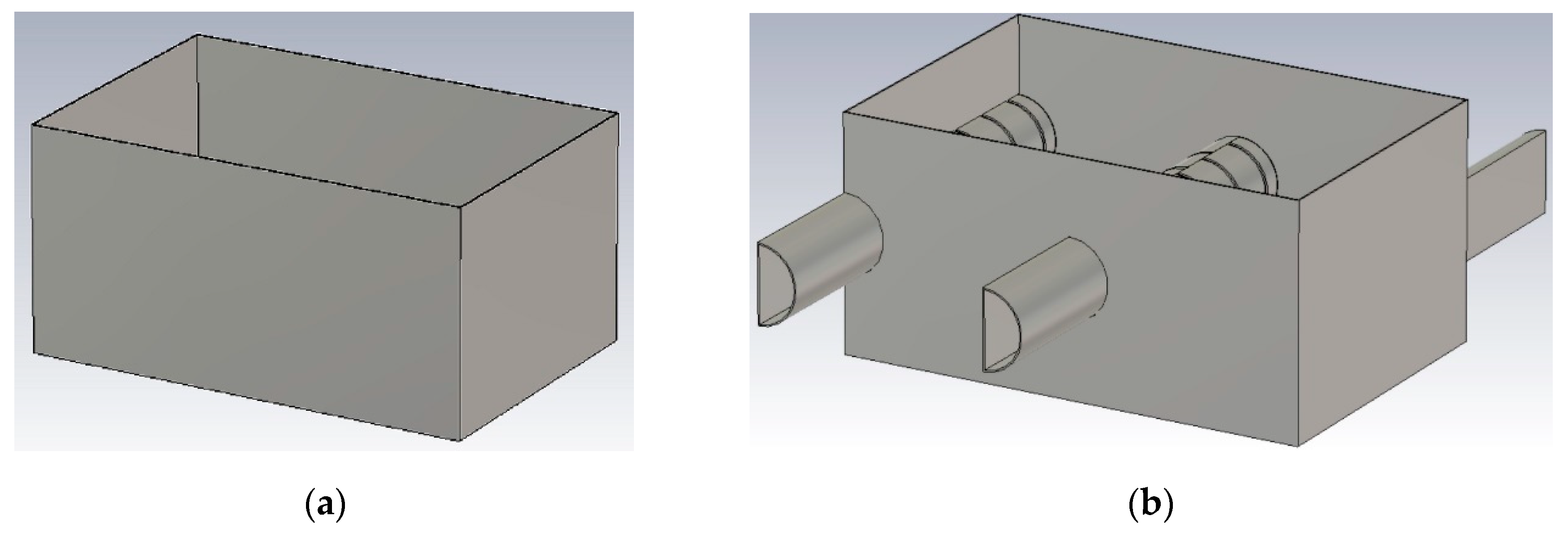1. Introduction
Microwave field-assisted techniques are widely used in agricultural production technologies and in the food industry [
1,
2,
3,
4]. In these processes, the uniformity of the microwave field distribution over the volume of the product under processing is normally ensured by the application of in-line processing, conveying units [
5]. In such processing units, a product is evenly distributed over a transporter to form a layer whose thickness is selected so that the microwave field penetrates to its depth without considerable attenuation. In such processing units, the productivity level of several tons per hour is hardly attainable, and it normally does not exceed 250 kg/h to 350 kg/h.
At the same time, microwave field-assisted grain drying, immediately in the course of harvesting, requires the application of grain-drying equipment with a performance rate from 5 t/h to 30 t/h [
6,
7]. As a rule, convective-type grain dryers are used for this purpose [
8,
9]. The major part of such grain dryers is designed to process grain in a dense layer, in which case the grain moves downward and is blown through with a drying agent. The drying agent (hot air) is delivered directly into the grain layer via air channels (ducts). The grain is heated by the air, and the moisture evaporated from it is transported with the drying agent outside the processing plant. In grain dryers using microwave effects produced on grain, a wet material is heated owing to the interaction with the microwave field. That is why this process requires less energy for drying. Therefore, grain dryers based on microwave field-assisted techniques are preferable in terms of energy-saving criteria. Two methods of microwave field application in shaft-type grain dryers are known. In the first case [
10], microwave effects are employed in the recirculation process, thus intensifying the moisture exchange between the wet and dried grain. In the second case [
11,
12], the grain layer is exposed to the convective-microwave effect. The microwave field supports moisture extraction from single seeds into the inter-grain space, while heated air brings moisture out of the grain layer. The authors deal with convective-microwave processing units of modular design, one of which is shown in
Figure 1, as an example.
Inside the module, waveguides with slot radiators are installed designed to deliver an electromagnetic microwave field into the grain. The number of waveguides in a module and the number of modules in a unit have to be defined with respect to the required grain processing performance, location of the unit, and its type (mobile or stationary). Grain moves downwards, in the form of a natural flow, being exposed to the microwave field. It is important to ensure the uniformity of grain exposure to the microwave field while it is within the active zones, between the waveguides with slot radiators. Fulfillment of this condition defines the operational efficiency of the unit (i.e., grain treatment uniformity and energy consumption).
It has been found out in our earlier studies [
13,
14] that variations in moisture content in grain under a convective-microwave zone substantially affect the depth of microwave field penetration into the grain layer. However, the dependence of microwave field direction on the moisture content variations had not been investigated. This may be substantially important for the uniformity of grain processing, in a convective-microwave zone.
Moreover, it was not yet clear whether the operational matching between the waveguide structure and the magnetron system changes depending on the moisture content in the grain. Do the radiation and total efficiency of waveguides change under these conditions? Results of studying these issues could contribute to better evaluating the operational efficiency of convective-microwave processing units, making it possible to define the limits of the moisture content in grain under processing within which such processing techniques are economically reasonable.
A convective-microwave zone is a resonator chamber filled with a product subject to processing (grain, in our case) [
15,
16]. Ideally, the resonator chamber structure has to be designed to have the maximum possible Q-factor value at the magnetron’s fundamental radiation frequency (2.45 GHz). In this case, all of the magnetron radiation energy will be enclosed and distributed over the grain layer [
17,
18]. However, unlike the microwave signal transmission techniques used in telecommunications, resonator chambers applied in technological processes for the treatment of various products are not void volumes. As a rule, they are entirely or partially filled with a material subject to processing or/and are occupied by certain structural elements. In what way might the Q-factor of the microwave-active zone change? The answer to this question will make it possible to define more accurately the parameters required for calculating convective-microwave zones.
2. Materials and Methods
2.1 Studying the Effect of Moisture Content on the Waveguide’s Efficiency and on the Distribution of Microwave Electromagnetic Field in a Grain Layer
The studies were performed by computer-assisted modeling of the distribution of the microwave electromagnetic field emitted from a semicircular waveguide with slot radiators into a grain layer (see
Figure 2). To achieve this purpose, the software package CST Microwave Studio [
19,
20,
21] was applied. The inner diameter of the semicircular waveguide was 50 mm.
This diameter value was selected to allow for the entire range of H-type waves to propagate in the waveguide. The wall thickness of the waveguide was 2 mm. The dielectric properties of wheat with a moisture content of 14%, 16%, 20%, 24%, and 26% were selected as the grain parameters input data. This range of moisture content variation falls within the most probable limits of its change during harvesting and storage.
The depth of the grain layer was assumed to be 100 mm from the waveguide’s walls. Therefore, the size of the grain layer was 254 mm vertically and 152 mm horizontally. Modelling was carried out without a metal casing of the microwave-active zone.
During the process of modelling, radiation directional diagrams were plotted for various values of the moisture content in the grain. These directional diagrams were studied from the following angles: a side elevation perpendicular to the upper wall of the semicircular waveguide, angle Phi = 0° (see
Figure 3a), and an end face view of the waveguide, angle Theta = 90° (
Figure 3b). The directional diagram for Phi = 0° allows for the evaluation of the distribution of the electromagnetic field along the waveguide and the microwave field penetration distance into the grain layer. The directional diagram for Theta = 90° enables the analysis of the microwave electromagnetic field distribution along the waveguide’s vertical axis. Moreover, each directional diagram shows the areas of maximum radiation density and maximum radiation vector in the grain layer (
Figure 3a and
Figure 3b).
2.2. Dependence of Radiation Efficiency on moisture Content in Grain
The optimal matching between the radiation source and the waveguide is an essential requirement that ensures the full transfer of the energy generated by a magnetron (Mats, 2010). In our case, when the waveguide performs the function of a radiator directly applied to a grain layer, it is important to find out whether the energy transfer efficiency depends on the moisture content in grain during processing. Therefore, the change in radiation efficiency indicators was defined for grains of various moisture content.
The antenna efficiency indicator depends on the relationship between the power supplied to the antenna and that emitted or dissipated inside it. An antenna is supposed to be effective when the major part of the power on its input is emitted into an external space. In antennas having low efficiency, the major part of the power is consumed inside them in the form of power loss or/and gets reflected from them.
Antenna radiation efficiency (or radiation efficiency) can be defined as the following relationship between the input power and that emitted by the antenna:
where Rad Eff is the antenna’s radiation efficiency that may be expressed in either arbitrary units or in dB, Prad is the power dissipated in the antenna’s output (dB), Pinp is the power supplied to the antenna’s input (dB).
One more indicator called the antenna’s total efficiency (
Tot Eff) is used for evaluating its efficiency. Total efficiency can be defined using the radiation efficiency indicator and the power loss in the antenna:
where Plos is the power loss in the antenna due to impedance mismatching.
In the course of modeling, the dependence of these two indicators on the moisture content in grain during processing in the convective-microwave zone was evaluated.
2.3. Studying the Effect of Moisture Content in Grain on the Microwave-Active Zone’s Q-Factor
In microwave energy transmission systems, the so-called resonators are normally applied to reduce power losses. These are cavities fully enclosed within a metal shell [
15]. Once an electromagnetic wave oscillation has been excited in such a cavity, it will exist there continuously.
In technological processes employing microwave field energy, such cavities are used to be filled with various materials subject to processing. In our case, resonators are applied to treat grain. We call a resonator chamber a ‘microwave-active zone’. Convective-microwave units for grain processing are composed of a certain number of microwave-active zones (resonator chambers) installed one upon another. Therefore, their specific feature is their open design. A microwave-active zone has no barriers either on the top nor on the bottom, and grain moves downwards, in a natural flow, from the upper microwave-active zone towards the discharge unit. Only the bottom active zone is bounded from beneath by a discharge tank casing.
The value of a resonator’s Q-factor shall be as high as possible to ensure an effective use of the radiation energy source for heating materials under processing.
When a resonator is filled with a conductive medium (such as wet grain), its Q-factor will depend on the energy loss in this medium [
22]:
where N represents energy loss in Watt-hours (Wh),
V stands for the volume of the resonator (m³),
E denotes electromagnetic field density (V/m),
and σ represents electric conductivity (S/m).
The total energy dissipated in the resonator can be defined from the following equation [
23]:
where ε represents dielectric permeability (F/m).
The
Q-factor is defined by the following relationship:
where f represents the magnetron’s frequency (Hz).
Taking into account (3) and (4), we have:
It is impossible to avoid power loss in the resonator's walls and directly in the medium that fills the resonator. Therefore, the overall
Q-factor of the microwave-active zone takes the following form [
23]:
where Qm is the Q-factor of the medium under processing,
and Qst is the Q-factor of the microwave-active chamber (resonator) structure made of steel.
Equation (6) makes it clear that the
Q-factor of a material under processing depends on its dielectric properties and its electric conductivity. These two parameters change in a rather wide range during grain processing in microwave fields [
24,
25,
26]. It has to be noted that these changes involve not only the reduction in moisture content and the increase in grain temperature but also the polarization of seeds in the electromagnetic field.
Furthermore, it is necessary to consider the fact that conventional calculation methods for the
Q-factor of resonators do not take into account any structures inside them. However, when dealing with microwave field applications in technological processes designed for processing agricultural products, it is necessary to consider auxiliary equipment (such as agitators, tanks, reflectors, etc.) installed inside a resonator chamber [
27,
28]. In our case, these are radiating waveguides mounted directly in the resonator chamber, which renders conventional calculation methods for the Q-factor of resonator chambers inapplicable.
3. Results
3.1. Microwave Field Directional Diagrams for Grains of Various Moisture Content
For ease of analysis, radiation directional diagrams for Phi = 0° are presented in linear form (
Figure 4 and
Figure 5). This directional diagram is shown in the angle range from 0° to 180°. It presents the distribution of the microwave field emitted from the slot radiators directly into a grain layer. In the case of linear representation, the entire waveguide length is divided into 180°. For a 400 mm long waveguide, one angular degree corresponds to 2.2 mm.
Our analysis of the directional diagrams made it possible to conclude the following. The maximum values on the directional diagrams for microwave radiation change their position depending on the moisture content in the grain under processing. These positions of radiation maxima are shown in Figures by dashed vertical lines. Thus, for wheat grain with a moisture content of 14% and 16%, they correspond to 32° and 16°, respectively, which are close to the radiation source. Conversely, for grain with a moisture content of 26%, the radiation maximum corresponds to 175°, i.e., it is located in the area close to the far end of the waveguide, in relation to the radiation source.
This conclusion is essentially important since it enables us to analyze changes in the electromagnetic field orientation within the convective-microwave zone depending on the moisture content in the grain. It follows from these directional diagrams that the area of maximum radiation intensity will drift along the waveguide, thus preventing grain overheating in only one particular waveguide's internal volume.
Furthermore, our analysis of the directional diagrams shows that the distribution uniformity of the microwave field intensity along the waveguide is better for grain containing 20% to 26% moisture compared to that having 16% to 14% moisture content. Microwave radiation power is lower for grain containing 20% to 26% moisture, and its distribution uniformity is better, with the exception of small areas inside the waveguide close to its middle. This gives us a reason to suggest that by drying grain with an initial moisture content exceeding 20%, we can avoid its overheating in any section of the electromagnetic field along the waveguide's axis. At the same time, processing grain (for instance, presowing treatment) with moisture content close to its standard value (14%) is associated with the risk of such local overheating. Therefore, this feature has to be taken into account while defining the technological conditions of grain processing, or relevant modifications have to be introduced into the convective-microwave zone's design structure.
Radiation directional diagrams for Theta = 90° are shown in
Figure 6.
The directional diagram presented in
Figure 6 shows that the pattern of the microwave electromagnetic field propagation changes depending on the moisture content in the grain during processing. While for a moisture content of 14% (
Figure 6a), the maximum radiation is directed towards the lower part of the waveguide at an angle of 45°, for the grain moisture content of 26% (
Figure 6b), this angle equals 0°. Clearly, both the amplitude and the grain layer area covered by radiation undergo changes.
The obtained data on the change of microwave radiation directional diagrams will be used in the course of designing convective-microwave zones, particularly when determining the distance between the waveguides for various unit modules, depending on the moisture content in the grain during processing, and when arranging waveguides relative to each other and to the module's walls.
3.2. Dependence of Radiation Efficiency on the Moisture Content in Grain
During the process of modeling, data on the dependence of radiation efficiency and total radiation efficiency of the waveguides on the moisture content in the grain during processing were obtained (see
Figure 7).
It follows from the obtained graphs (see
Figure 7) that the reduction of moisture content in the grain from 26% to 14% leads to a growth in the waveguide’s radiation efficiency by 15.1% (from 58.294 dB to 68.729 dB). In this case, not only the value of radiation efficiency but also the shape of its characteristic change with the change in the magnetron radiation frequency. The fundamental magnetron frequency that was selected for modeling (2.45 GHz) is critical for the
Rad Eff = f
(f) dependence, since the magnetron is capable of generating oscillations in a rather narrow frequency range of ±10% (from 2.426 GHz to 2.475 GHz). That is why an additional reduction in radiation efficiency takes place when the magnetron radiation frequency shifts towards the lower limit of this range.
The total radiation efficiency (
Figure 7b) also decreases with the growth of the moisture content in the grain (from –11.27 dB to –21.7 dB). This suggests that the growth of the moisture content in the grain subject to processing in the convective-microwave zone results in an increase in microwave energy loss in the waveguide. This situation occurs because the distance of microwave field penetration into the grain layer decreases with its moisture content. The radiation reflected from the grain gets lost in the waveguide.
These results have to be considered when matching the waveguides and when defining the algorithm of the convective-microwave unit's operation.
3.3 Dependence of Microwave Field Distribution in the Active Zone of a Single Magnetron on the Moisture Content in Grain
During the grain drying process, the grain moves under its own weight within a completely filled convective-microwave zone, passing through different microwave-activated processing areas sequentially. This leads to the grain losing moisture. During the process of grain transport, a situation may occur where grain portions of various moisture content enter the active zone of the same magnetron. This situation was also simulated.
Figure 8 shows the spatial distribution pattern of microwave power dissipated inside grain layers with various moisture content that entered the active zone of a single radiating waveguide. The upper part of the grain layer has a moisture content of
W = 16%, while its bottom portion has a moisture content of
W = 14%. Isopleths for microwave power absorbed by the grain are presented for the outermost grain layer point (152 mm from the waveguide's rear wall and 100 mm from the waveguide's wall nearest to the grain layer).
It is evident from
Figure 8 that the wetter the grain is, the more microwave energy it absorbs. Despite the fact that grain with different moisture content areas is exposed to the microwave field of the same radiating waveguide, grain fractions with higher moisture content get heated more intensively compared to those containing less moisture. This means that the radiation efficiency in the active zone of a single waveguide will not remain constant during the grain processing. Additionally, it varies depending on the position of the particular radiating waveguide along the vertical axis of the convective-microwave zone.
Therefore, a change in the moisture content of the grain in the microwave-active zone results in a change in the microwave impact amplitude. The direction of its maximum effect both along the waveguide and in relation to the radiating surface also changes. The uniformity of the microwave field radiation along the waveguide also undergoes a change. These conclusions have to be considered when designing microwave-active zone structures and when determining the operation algorithms of magnetrons and the discharge unit.
3.4. Dependence of the Convective-Microwave Zone's Q-Factor on the Moisture Content in Grain
These studies were carried out in two steps. In the first stage, the influence of the waveguides introduced into the convective-microwave zone on the Q-factor value was evaluated. In the second stage, the change in the convective-microwave zone's Q-factor was studied for grain of various moisture contents in the presence of waveguides.
Simulations were performed to determine the
Q-factor using the software package CST Microwave Studio 2019 in order to ascertain how and to what extent waveguides in the microwave active zone affect the
Q-factor. Two configurations of the microwave active zone casing were studied, i.e. with (
Figure 9b) and without waveguides (
Figure 9a).
Results of calculations are presented in
Table 1.
It is evident from the data presented in
Table 1 that, for the microwave-active zone without waveguides (in italics), the third and fourth frequency modes are the most closely adjacent frequencies to that of the magnetron (2.45 GHz). However, their corresponding
Q-factor values are not high (2.624 and 1.939, respectively). The results of calculating the microwave-active zone with four waveguides show that for this microwave-active zone design option, the most closely adjacent resonance frequency equals 2.456675 GHz (in italics). The
Q-factor value for this frequency is 15.93. There is no resonance frequency closely adjacent to that of the magnetron.
These simulation results provide evidence that introducing any technological equipment into the so-called resonators leads to a substantial change in the Q-factor.
The dependence of the
Q-factor on the moisture content in the grain loaded into the convective-microwave zone was also studied. Calculations were made for the grain moisture content range of
W = 14% to 26%. It is precisely within this moisture content range that the grain is exposed to the effect of the microwave field in the processing area. The results of the studies are listed in
Table 2.
The data listed in
Table 2 show that none of the resonance frequency modes is identical to that of the magnetron.
Q-factor values for resonance frequencies closely adjacent to the magnetron’s fundamental frequency vary in the range from 0.8173 to 6.949 for various modes. Moreover, they differ substantially even for the same grain’s moisture content value. This is easily explicable since a number of different wave types participate in the process of microwave energy transfer, and their resonance frequencies change depending on varying dielectric properties of materials present in the processing zone. That's why radiation efficiency changes as well, as noted above.
Results of calculating the Q-factor of resonators used in grain processing technologies for materials of various moisture contents have shown the following. The Q-factor of the microwave active zone substantially depends on the moisture content in the grain. At the same time, no distinct correlation between the values of microwave radiation density for particular frequency modes and various moisture contents in the grain has been observed.
4. Conclusions
Our studies based on the results of computer modeling using the software package CST have led us to the following conclusions:
- Studies of the directional diagrams show that the pattern of microwave electromagnetic field propagation in a grain layer changes depending on the moisture content of the grain under processing. Both the radiation amplitude and the grain layer's coverage area by radiation undergo changes.
- Changes in the moisture content of the grain under processing in the microwave-active zone result in a 15.1% growth in radiation efficiency of the waveguides (from 58.294 dB to 68.729 dB), as the moisture content decreases from 26% to 14%. The total radiation efficiency also increases (from –21.7 dB to –11.27 dB). Furthermore, not only does the value of the radiation efficiency change, but also the shape of its characteristic changes for different magnetron radiation frequencies. The obtained data indicate that the loss of microwave energy in a waveguide increases with the moisture content in the grain under processing.
- Changes in the moisture content of the grain present in a microwave-active zone result in changes to the level of exposure and their maximum orientation, both along the waveguide and in relation to the radiating surface. The degree of uniformity in the radiation distribution along the waveguide also changes.
- Studying the effect of the specific design features of the microwave-active zone's design structure and the moisture content in the grain under processing has clarified that the Q-factor of a grain treatment area significantly depends on its specific design and the arrangement of technological components inside it. Variations in the moisture content of the grain subject to processing and its temperature have a strong effect on the Q-factor value. Therefore, the Q-factor plays only a secondary role, and there is no practical reason to take it into account when calculating microwave-active zones.
The obtained results can serve as a basis for designing microwave-active zones and developing operation algorithms for technological units used in grain processing using the convective-microwave method.
Author Contributions
Conceptualization, A.N.V.; methodology, D.B.; software, validation, formal analysis, A.A.V., A.N.V. and D.B.; investigation, A.A.V. and D.T.; resources, data curation, A.N.V. and D.T.; writing—original draft preparation, writing—review and editing, visualization, A.A.V. and D.T.; supervision, project administration, A.N.V.; funding acquisition, A.A.V. All authors have read and agreed to the published version of the manuscript.
Funding
This research was supported by Federal Scientific Agroengineering Center VIM (RF state assignment No FGUN-2022-0004)
Conflicts of Interest
The authors declare no conflicts of interest.
References
- SOYER, A.; KOLSARICI, N.; CANDOĞAN, K. Effect of Conventional and Microwave Cooking Methods on Some Nutritive Contents and Quality Properties of Chicken Meat. Turkish Journal of Agriculture and Forestry 1999, 23, 289–296. [Google Scholar]
- Abano, E.E. Kinetics and Quality of Microwave-Assisted Drying of Mango ( Mangifera Indica ). International Journal of Food Science 2016, 2016, 1–10. [Google Scholar] [CrossRef] [PubMed]
- Kovalev, A.V.; Spiridonov, O.B.; Lysenko, I.E.; Ezhova, O.A. Method and System of Pre-Sowing Microwave Treatment of Agricultural Crop Seeds. International Journal of Engineering Research and Technology 2020, 13, 3964. [Google Scholar] [CrossRef]
- Bruce, R.M.; Atungulu, G.G.; Sadaka, S.; Smith, D. Impact of Specific Energy Input of a 915 MHz Microwave Dryer on Quality, Functional, and Physicochemical Properties of Different Rice Cultivars. Cereal Chem 2021, 98, 557–570. [Google Scholar] [CrossRef]
- Vasil’yev, A.N.; Vasil’yev, A.A.; Dorokhov, A.S.; Budnikov, D.A. Trends in the Use of the Microwave Field in the Technological Processes of Drying and Disinfection of Grain. AMA,Agricultural Mechanization in Asia, Africa and Latin America 2020, 51, 63–68. [Google Scholar]
- Jia, C.; Wang, L.; Guo, W.; Liu, C. Effect of Swing Temperature and Alternating Airflow on Drying Uniformity in Deep-Bed Wheat Drying. Applied Thermal Engineering 2016, 106, 774–783. [Google Scholar] [CrossRef]
- Sabashkin, V.A.; Toropov, V.R. THE CHOICE OF GRAIN CLEANING-AND-DRYING UNITS IN AREAS WITH HIGH GRAIN HUMIDITY. Sib. vestn. s-h. nauki 2018, 48, 58–64. [Google Scholar] [CrossRef]
- ZHlobov, N.V.; CHertkov, G.YA.; Sagajdachnyj, D.A. Obzor i analiz sushilok zerna. In Proceedings of the sbornik statej Mezhdunarodnoj nauchno-prakticheskoj konferencii. 2019; OOO “Aeterna”; 2019; pp. 26–30. [Google Scholar]
- Kirmasov, V.YU.; Baskakov, I.V.; Orobinskij, V.I.; Bolotov, D.B.; Rasporov, A.S.; Kondobarova, E.A.; SHarova, YU.A. Obzor Konstruktivnyh Skhem Zernosushilok. In Proceedings of the Prikladnye voprosy fiziki; Voronezhskij gosudarstvennyj agrarnyj universitet im. Imperatora Petra I: Voronezh, 2022; pp. 318–325. [Google Scholar]
- Kozhuhov, V.A.; Ushkalov, V.YU. Recirkulyacionnaya zernosushilka shahtnogo tipa s aktivnym ventilirovaniem i SVCH-aktivaciej zerna.; Krasnoyarskij GAU: Krasnoyarsk, 2018; Vol. 2, pp. 118–121. [Google Scholar]
- U. S. Shivhare; G. S. V. Raghavan; R. G. Bosisio Microwave Drying of Corn I. Equilibrium Moisture Content. Transactions of the ASAE 1992, 35, 947–950. [Google Scholar] [CrossRef]
- Gursoy, S.; Choudhary, R.; Watson, D.G. Microwave Drying Kinetics and Quality Characteristics of Corn. Biol Eng 2013, 6. [Google Scholar]
- Vasiliev, A.N.; Goryachkina, V.P.; Budnikov, D. Research Methodology for Microwave-Convective Processing of Grain. International Journal of Energy Optimization and Engineering 2020, 9, 1–11. [Google Scholar] [CrossRef]
- Budnikov, D.A.; Vasil'ev, A.N.; Vasil'ev, A.A. Proektirovanie rabochih zon ustanovok SVCH-konvektivnoj obrabotki zerna putem elektrodinamicheskogo modelirovaniya; OOO PF «Kartush»: Oryol, 2022; ISBN 978-5-9708-0996-9. [Google Scholar]
- Didenko, A.N. SVCh-Ėnergetika: Teorii︠a︡ i Praktika; Nauka: Moskva, 2003; ISBN 978-5-02-002869-2. [Google Scholar]
- Vasinkina, E.Yu.; Trigorly, S.V.; Kadykova, Yu.A.; Kalganova, S.G. MODELING OF MICROWAVE HEAT TREATMENT OF COMPOSITE MATERIALS IN RESONATOR-TYPE CHAMBERS. Herald Of Technological University 2022, 25, 107–110. [Google Scholar] [CrossRef]
- Kabdin, N.E.; Andreev, S.A. Obespechenie Ravnomernosti SVCH-Obrabotki Sel'skohozyajstvennyh Materialov v Ob"emnom Rezonatore. Mezhdunarodnyj tekhniko-ekonomicheskij zhurnal 2018, 42–49. [Google Scholar]
- Mallanna, S.D.; Viswanath, K. Performance Analysis of Resonators for Microwave Applications. In Proceedings of the 2018 International Conference on Electrical, Electronics, Communication, Computer, and Optimization Techniques (ICEECCOT); IEEE: Msyuru, India, December 2018; pp. 741–745. [Google Scholar] [CrossRef]
- Ivanilova, E.E.; Ivanilova, S.V. Ispol'zovanie programmnoj sredy CST Microwave Studio dlya povysheniya ekonomicheskoj effektivnosti proizvodstva uzkopolosnyh volnovodnyh polosno-propuskayushchih SVCH-fil'trov. Matematicheskoe i komp’yuternoe modelirovanie v ekonomike, strahovanii i upravlenii riskami 2021, 80–85. [Google Scholar]
- Kasimova, A.U. Sravnitel'nyj analiz chislennyh metodov modelirovaniya mikropoloskovoj antenny. Problemy avtomatiki i upravleniya 2022, 31–41. [Google Scholar]
- CHerkashin, D.E.; Hakimov, N.T. Ispol'zovanie paketa programm CST Microwave Studio dlya raschyota effektivnoj ploshchadi rasseivaniya razlichnyh ob"ektov. In Proceedings of the Sbornik nauchnyh trudov po materialam II Mezhdunarodnoj nauchno-prakticheskoj konferencii; NIC «Innova»: Anapa, 2022; pp. 62–66. [Google Scholar]
- Gustafsson, M.; Cismasu, M.; Nordebo, S. Absorption Efficiency and Physical Bounds on Antennas. International Journal of Antennas and Propagation 2010, 2010, 1–7. [Google Scholar] [CrossRef]
- Mitel'man, YU.E.; Abdullin, R.R.; Sychugin, R.R.; SHabunin, S.S. Raschet i izmerenie harakteristik ustrojstv SVCH i antenn; FGAOU VPO UFU: Ekaterenburg, 2016; ISBN 978-5-7996-1821-6. [Google Scholar]
- Venkatesh, M.S.; Raghavan, G.S.V. An Overview of Microwave Processing and Dielectric Properties of Agri-Food Materials. Biosystems Engineering 2004, 88, 1–18. [Google Scholar] [CrossRef]
- Nelson, S.O. Dielectric Properties Data. In Dielectric Properties of Agricultural Materials and their Applications; Elsevier, 2015; pp. 211–246. ISBN 978-0-12-802305-1. [Google Scholar] [CrossRef]
- Harlanov, A.V.; Harlanova, T.S. Prikladnaya elektrodinamika; VolgGTU: Volgograd, 2023; ISBN 978-5-9948-4626-1. [Google Scholar]
- Tang, X.; Fan, D.; Hang, F.; Yan, B.; Zhao, J.; Zhang, H. Effect of Microwave Heating on the Dielectric Properties and Components of Iron-Fortified Milk. Journal of Food Quality 2017, 2017, 1–10. [Google Scholar] [CrossRef]
- Waseem, M.; Akhtar, S.; Ahmad, N.; Ismail, T.; Lazarte, C.E.; Hussain, M.; Manzoor, M.F. Effect of Microwave Heat Processing on Nutritional Indices, Antinutrients, and Sensory Attributes of Potato Powder-Supplemented Flatbread. Journal of Food Quality 2022, 2022, 1–10. [Google Scholar] [CrossRef]
|
Disclaimer/Publisher’s Note: The statements, opinions and data contained in all publications are solely those of the individual author(s) and contributor(s) and not of MDPI and/or the editor(s). MDPI and/or the editor(s) disclaim responsibility for any injury to people or property resulting from any ideas, methods, instructions or products referred to in the content. |
© 2024 by the authors. Licensee MDPI, Basel, Switzerland. This article is an open access article distributed under the terms and conditions of the Creative Commons Attribution (CC BY) license (http://creativecommons.org/licenses/by/4.0/).
